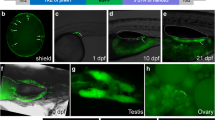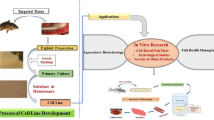Abstract
Production of xenogeneic gametes from large-bodied, commercially important marine species in closely related smaller surrogates with short generation times may enable rapid domestication of the targeted species. In this study, we aimed to produce gametes of Japanese yellowtail (Seriola quinqueradiata) using jack mackerel (Trachurus japonicus) as a surrogate with a smaller body size and shorter maturation period. Donor spermatogonia were collected from the testes of yellowtail males and transferred into the peritoneal cavity of 10- and 12-day-old jack mackerel larvae. Twenty days later, 59.5 % of the recipients survived of which 88.2 % had donor-derived germ cells in their gonads. One year later, genomic DNA templates were prepared from the semen of 96 male recipients and subjected to polymerase chain reaction (PCR) analyses using primers specific for the yellowtail vasa sequence, resulting in the detection of positive signals in semen from two recipients. The milt collected from the recipients was used for fertilization with yellowtail eggs. Of eight hatchlings obtained from the crosses, two were confirmed to be derived from donor yellowtail by DNA markers, although the others were gynogenetic diploids. These findings indicate that it is possible to produce donor-derived sperm in xenogeneic recipients with a smaller body size and shorter generation time by transplanting spermatogonia. Thus, the xenogeneic transplantation of spermatogonia might be a potential tool to produce gametes of large-bodied, commercially important fish, although the efficiency of the method requires further improvement. This is the first report demonstrating that donor-derived sperm could be produced in xenogeneic recipient via spermatogonial transplantation in carangid fishes.










Similar content being viewed by others
References
Aoki J, Kai W, Kawabata Y, Ozaki A, Yoshida K, Tsuzaki T, Fuji K, Koyama T, Sakamoto T, Araki K (2014) Construction of a radiation hybrid panel and the first yellowtail (Seriola quinqueradiata) radiation hybrid map using a nanofluidic dynamic array. BMC Genomics 15:165
Carpenter KE, Niem VH (1999) FAO species identification guide for fishery purposes. The living marine resources of the Western Central Pacific, vol 4, Bony fishes part 2 (Mugilidae to Carangidae). FAO, Rome
Chuda H, Nakao T, Arakawa T, Matsuyama M (2005) Effects of oocyte diameter on ovulation time, quantity and quality of eggs in yellowtail Seriola quinqueradiata in inducing ovulation with HCG (in Japanese with English abstract). Nippon Suisan Gakkaishi 71:942–946
Ciruna B, Weidinger G, Knaut H, Thisse B, Thisse C, Raz E, Schier A (2002) Production of maternal-zygotic mutant zebrafish by germ-line replacement. Proc Natl Acad Sci U S A 99:14919–14924
Cultured Aquatic Species Information Programme. Seriola quinqueradiata. (2005) FAO, Rome. http://www.fao.org/fishery/culturedspecies/Seriola_quinqueradiata/en Accessed 2 Feb 2015
Fishstat Database (2015) FAO, Rome. http://www.fao.org/fishery/statistics/en Accessed 2 Feb 2015
Gushiken S (1988) Phylogenetic relationship of the Perciform genera of the family Carangidae. Japan J Ichthyol 34:443–461
Hamada K, Mushiake K (2006) Advanced spawning technique and its advantages in stock enhancement and aquaculture of the yellowtail Seriola quinqueradiata (in Japanese with English abstract). Nippon Suisan Gakkaishi 72:250–253
Higuchi K, Takeuchi Y, Miwa M, Yamamoto Y, Tsunemoto K, Yoshizaki G (2011) Colonization, proliferation, and survival of intraperitoneally transplanted yellowtail Seriola quinqueradiata spermatogonia in nibe croaker Nibea mitsukurii. Fish Sci 77:69–77
Kijima A, Taniguchi N, Ochiai A (1986) In: Uyeno T, Arai R, Taniuchi T, Matsuura K (ed) Indo-Pacific fish biology: Proc. of the 2nd International Conference on Indo-Pacific Fishes. Ichthyological Soc. of Japan, Tokyo
Laroche WA, Smith-Vaniz WF, Richardson SL (1984) In: Moser HG, Richards WJ, Cohen MP, Fahay AW, Kendall AW Jr, Richardson SL (eds) Ontogeny and systematics of fishes. Kansas, American Society of Ichthyologists and Herpetologists
Lubzens E, Young G, Bobe J, Cerdà J (2010) Oogenesis in teleosts: how fish eggs are formed. Gen Comp Endocrinol 165:367–389
Masuda R (2006) Ontogeny of anti-predator behavior in hatchery-reared jack mackerel Trachurus japonicus larvae and juveniles: patchiness formation, swimming capability, and interaction with jellyfish. Fish Sci 72:1225–1235
Morita T, Kumakura N, Morishima K, Mitsuboshi T, Ishida M, Hara T, Kudo S, Miwa M, Ihara S, Higuchi K, Takeuchi Y, Yoshizaki G (2012) Production of donor-derived offspring by allogeneic transplantation of spermatogonia in the yellowtail (Seriola quinqueradiata). Biol Reprod 86:1–11
Mushiake K, Kawano K, Kobayashi T, Yamasaki T (1998) Advanced spawning in yellowtail, Seriola quinqueradiata, by manipulations of the photoperiod and water temperature. Fish Sci 64:727–731
Nakada M (2008) In: Lovatelli A, Holthus PF (ed) Capture-based aquaculture. Global Overview. FAO Fisheries Technical Paper, No. 508. FAO, Rome
Nyuji M, Fujisawa K, Imanaga Y, Kitano H, Yamaguch A, Matsuyama M (2013) GnRHa-induced spawning of wild-caught jack mackerel Trachurus japonicus. Fish Sci 79:251–258
Ochiai A, Mutsutani K, Umeda S (1983) On the first year’s growth, maturity and artificial spawning of cultured jack mackerel (in Japanese with English abstract). Bull Jpn Soc Sci Fish 49:541–545
Ohara E, Nishimura T, Sakamoto T, Nagakura Y, Mushiake K, Okamoto N (2003) Isolation and characterization of microsatellite loci from yellowtail Seriola quinqueradiata and cross-species amplification within the genus Seriola. Mol Ecol Notes 3:390–391
Ohara E, Nishimura T, Nagakura Y, Sakamoto T, Mushiake K, Okamoto N (2005) Genetic linkage maps of two yellowtails (Seriola quinqueradiata and Seriola lalandi). Aquaculture 244:41–48
Oka M, Mori K (2006) A review on spawning under captive condition in Japanese horse mackerel Trachurus japonicus (in Japanese with English abstract). Bull Fish Res Agency Suppl 4:151–155
Okutsu T, Suzuki K, Takeuchi Y, Takeuchi T, Yoshizaki G (2006) Testicular germ cells can colonize sexually undifferentiated embryonic gonad and produce functional eggs in fish. Proc Natl Acad Sci U S A 103:2725–2729
Okutsu T, Shikina S, Kanno M, Takeuchi Y, Yoshizaki G (2007) Production of trout offspring from triploid salmon parents. Science 317:1517
Okutsu T, Takeuchi Y, Yoshizaki G (2008a) In: Tsukamoto K, Kawamura T, Takeuchi T, Beard TD Jr, Kaiser MJ (eds) Fisheries for global welfare and environment, 5th World Fisheries Congress 2008. Tokyo, TERRAPUB
Okutsu T, Kobayashi T, Takeuchi Y, Yoshizaki G (2008b) Identification of donor-derived germ cells and spermatozoa in xenogeneic recipient using species-specific primers against vasa gene in germ cell transplantation experiments (in Japanese with English abstract). Fish Genet Breed Sci 37:29–36
Ozaki A, Yoshida K, Fuji K, Kubota S, Kai W, Aoki J, Kawabata Y, Suzuki J, Akita K, Koyama T, Nakagawa M, Hotta T, Tsuzaki T, Okamoto N, Araki K, Sakamoto T (2013) Quantitative trait loci (QTL) Associated with Resistance to a monogenean parasite (Benedenia seriolae) in yellowtail (Seriola quinqueradiata) through genome wide analysis. PLoS ONE 8:e64987
Reed DL, Carpenter KE, deGravelle MJ (2002) Molecular systematics of the Jacks (Perciformes: Carangidae) based on mitochondrial cytochrome b sequences using parsimony, likelihood, and Bayesian approaches. Mol Phylogenet Evol 23:513–524
Saito T, Goto-Kazeto R, Arai K, Yamaha E (2008) Xenogenesis in teleost fish through generation of germ-line chimeras by single primordial germ cell transplantation. Biol Reprod 78:159–166
Sawatari E, Shikina S, Takeuchi T, Yoshizaki G (2007) A novel transforming growth factor-beta superfamily member expressed in gonadal somatic cells enhances primordial germ cell and spermatogonial proliferation in rainbow trout (Oncorhynchus mykiss). Dev Biol 301:266–275
Takeuchi Y, Yoshizaki G, Takeuchi T (2004) Surrogate broodstock produces salmonids. Nature 430:629
Takeuchi Y, Higuchi K, Yatabe T, Miwa M, Yoshizaki G (2009) Establishment of spermatogonial cell transplantation in Nibe croaker (Nibea mitsukurii). Biol Reprod 81:1055–1063
Wong TT, Saito T, Crodian J, Collodi P (2011) Zebrafish germline chimeras produced by transplantation of ovarian germ cells into sterile host larvae. Biol Reprod 84:1190–1197
Yano A, Suzuki K, Yoshizaki G (2008) Flow-cytometric isolation of testicular germ cells from rainbow trout (Oncorhynchus mykiss) carrying the green fluorescent protein gene driven by trout vasa regulatory regions. Biol Reprod 78:151–158
Yazawa R, Takeuchi Y, Higuchi K, Yatabe T, Kabeya N, Yoshizaki G (2010) Chub mackerel gonads support colonization, survival, and proliferation of intraperitoneally transplanted xenogenic germ cells. Biol Reprod 82:896–904
Author information
Authors and Affiliations
Corresponding author
Rights and permissions
About this article
Cite this article
Morita, T., Morishima, K., Miwa, M. et al. Functional Sperm of the Yellowtail (Seriola quinqueradiata) Were Produced in the Small-Bodied Surrogate, Jack Mackerel (Trachurus japonicus). Mar Biotechnol 17, 644–654 (2015). https://doi.org/10.1007/s10126-015-9657-5
Received:
Accepted:
Published:
Issue Date:
DOI: https://doi.org/10.1007/s10126-015-9657-5




